At a time when depictions of African Americans in the media were largely negative and used racist stereotypes, Chicago-based Ebony magazine was founded in 1945 by John H. Johnson at the height of the Chicago Black Renaissance. It was the flagship magazine of Johnson Publishing Company, which published other iconic magazines including Jet and Negro Digest, and mirrored Life magazine’s format.
Ebony’s content initially focused on African American achievement and celebrity, but over time the magazine paid more attention to issues of social justice. Starting in the 1960s through the mid-1990s, once a year, typically in August, Ebony published a special issue devoted to timely themes with dramatic covers. Five of these issues are on display in our exhibition Designing for Change: Chicago Protest Art of the 1960s–70s. Learn more about these special issues below, and then come to the Chicago History Museum to see them in person.
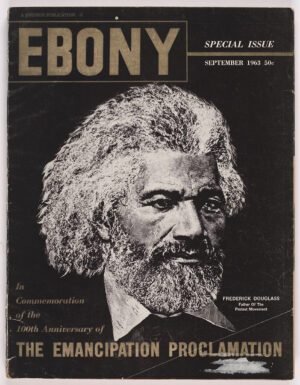
Ebony Special Issue: The Emancipation Proclamation, September 1963
Cover designed by Herbert Nipson and Norman Hunter
Ebony’s first special issue commemorated the 100th anniversary of the Emancipation Proclamation. But instead of Abraham Lincoln, who authored the decree, the cover featured Frederick Douglass, noted African American abolitionist who often criticized Lincoln for moving too slowly against slavery during the Civil War. The entire 236-page issue was devoted to 100 years of hope and struggle for African Americans and contained contributions from guest authors, including President John F. Kennedy and former Presidents Hoover, Truman, and Eisenhower. In a “Statement from the Publisher,” John H. Johnson wrote that the Emancipation centennial is “a time for rededication to the unfinished business of eradicating segregation and discrimination from every facet of American life.”
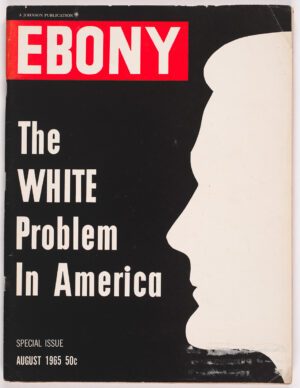
Ebony Special Issue: The White Problem in America, August 1965
Cover designed by Herbert Temple
At the height of the Civil Rights Movement, Herbert Temple, Ebony’s lead designer, created this provocative cover that addressed American racism. Temple, a graduate of the School of the Art Institute of Chicago, also designed for Negro Digest/Black World, also on view in Designing for Change. The issue was devoted to examining the “race problem” in the United States with a “thorough study of the man who created the problem.” The “Publisher’s Statement” reads: “In this issue we, as Negroes, look at the white man today with the hope that our effort will tempt him to look at himself more thoroughly. With a better understanding of himself, we trust that he may then understand us better—and this nation’s most vital problem can then be solved.”
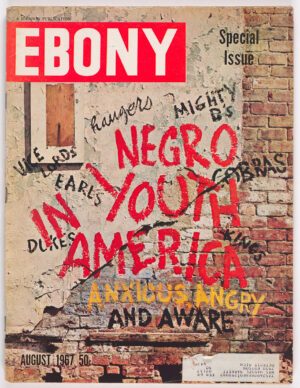
Ebony Special Issue: Negro Youth in America, August 1967
Cover designed by Cecil Ferguson
This issue focused on challenges faced by African Americans under age 25, including economic hardships, gangs, education, employment, and rural isolation. It also looked at the contributions Black youth made to inspire the sit-in movement as well as the arts, like popular dance and music. These topics were then combined to focus on the challenges youth face in having the educational and economic tools they need to extend into adulthood the cultural contributions they have already made. The cover of the issue was based on a mural created by Ebony artist Cecil Ferguson and photographer Lacey Crawford. Note, the term “Negro” remained in use at the time, but it was losing favor to the more contemporary term “Black.”
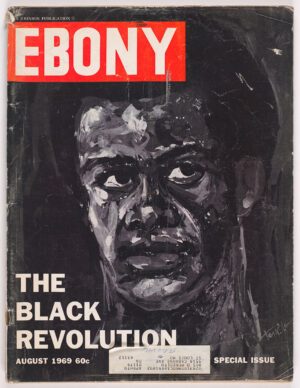
Ebony Special Issue: The Black Revolution, August 1969
Cover designed by Herbert Temple
Ebony addressed the Black Power Movement in this issue with a dramatic cover portrait of a “Black Revolutionary” by Herbert Temple. Staring with a “Publisher’s Statement” that acknowledged an end to the promise of the March On Washington following the assassination of Martin Luther King Jr. the previous year, the issue featured many articles expressing different points of view on the Black Revolution. Contributions came from Black leaders, philosophers, activists, and historians, including “The Black Panthers” by Huey P. Newton and “The Myth of the Revolutionaries” by longtime Civil Rights leader Bayard Rustin, who was more critical of the movement.
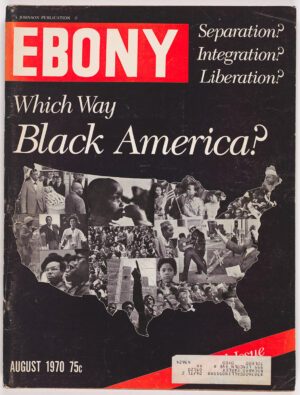
Ebony Special Issue: Which Way Black America?, August 1970
Cover designed by Herbert Temple
Herbert Temple’s cover illustrates the conversation among African Americans about “just where the black man stands in America today.” The issue brought together thinkers representing separatist, integrationist, and liberationist perspectives. Among these articles were “Integration” by Roy Wilkins and “A Dialogue on Separatism” by Jesse Jackson Jr. and Alvin Puissant. Lerone Bennett Jr. also contributed an article about the historical roots of racial division dating back to colonial America. In his “Publisher’s Statement,” John H. Johnson noted that in spite of the wide range of views, “there is a stronger unity among blacks today than at any other time in history.”